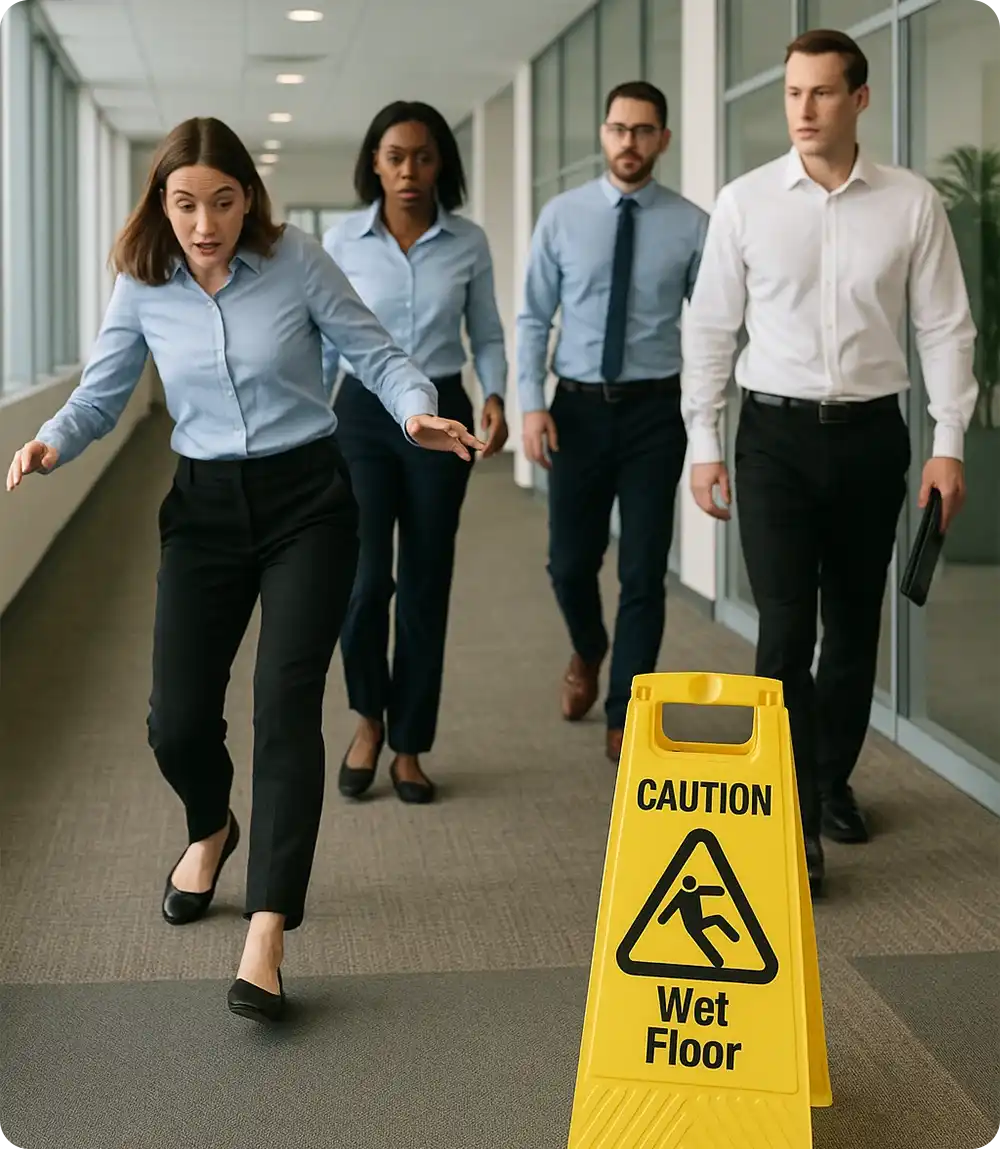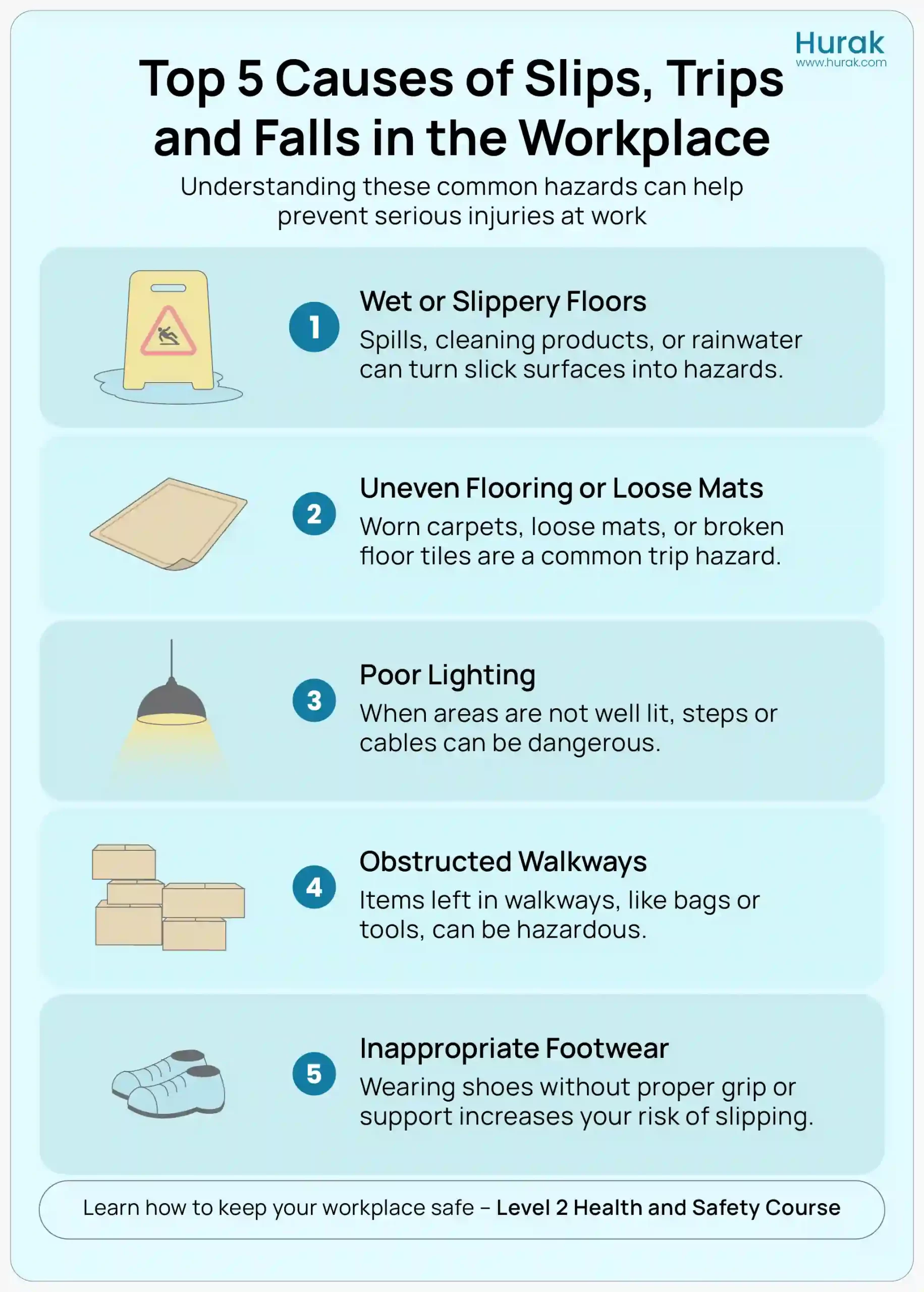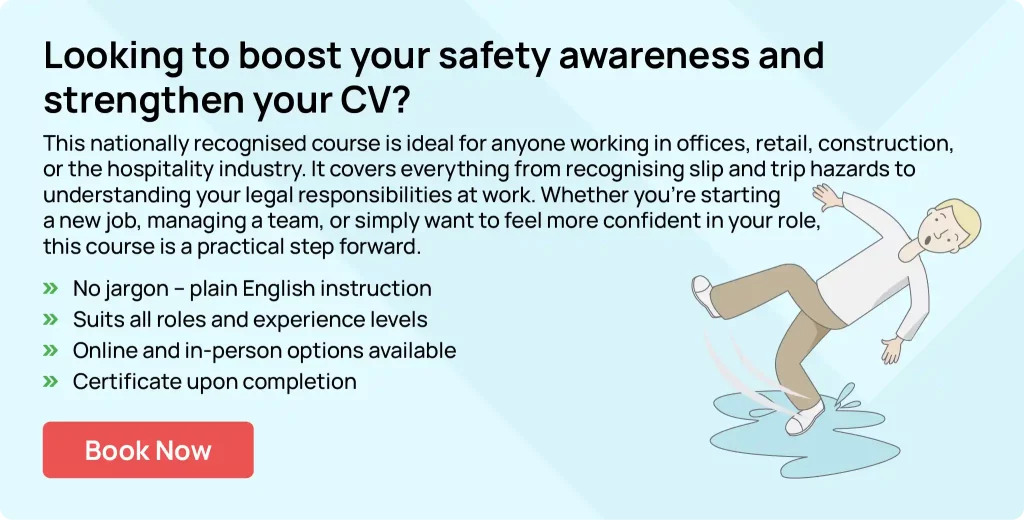
Slips, trips and falls are some of the most common accidents at work, yet they’re often dismissed as minor incidents. A wet floor, an uneven mat, or a loose cable may seem harmless, but when they lead to a fall, the consequences can range from minor bruises to broken bones or even more severe injuries. For both individuals and businesses, the cost of these incidents goes beyond physical injury. They affect confidence, productivity, legal compliance, and in some cases, a person’s ability to continue working.
In this article, we’ll explore what makes slips, trips and falls so common, how they affect everyone from beginners to senior professionals, and what simple but effective measures can prevent them.
What Are Slips, Trips and Falls?
Slips occur when there is insufficient grip between a person’s footwear and the walking surface, often due to moisture, grease, or smooth flooring. Trips occur when an unexpected object or uneven surface interrupts your movement, causing you to lose your balance and fall. Falls are the result of either falling from the same level (such as falling over) or from a height (like missing a step or stumbling off a ladder).
Although they might sound like everyday mishaps, they are the leading cause of non-fatal injuries in UK workplaces, as reported by the Health and Safety Executive (HSE).
Why These Incidents Matter
It’s easy to overlook slips and trips as embarrassing but forgettable accidents. However, these incidents carry serious consequences. For workers, they can lead to sprains, fractures, and long periods off work. In more severe cases, they cause long-term mobility issues or chronic pain. For employers, the cost includes time lost, compensation claims, and sometimes legal action if proper precautions weren’t in place.
For people just entering the workforce, this can be especially troubling. An injury at the start of your career can delay training, reduce your confidence, and even cause you to miss employment opportunities. For more seasoned professionals, injuries like these can disrupt important projects or make it difficult to meet deadlines and team responsibilities.
Common Causes of Slips and Trips
Most slip and trip hazards are avoidable with basic attention to detail and good workplace habits. The most common causes include:
- Wet or recently cleaned floors without warning signs
- Poorly lit areas, such as stairwells or back rooms
- Cables or wires trailing across walkways
- Loose floor coverings like mats or tiles
- Cluttered walkways with items left on the floor
- Inadequate footwear for the surface or environment
These are not isolated to construction sites or warehouses; they occur just as easily in offices, shops, schools, and hospitals.

Legal Responsibilities
What Employers Must Do
Under the Health and Safety at Work Act 1974, employers are legally required to protect the health, safety and welfare of their employees. This includes identifying and addressing slip and trip hazards.
The Management of Health and Safety at Work Regulations 1999 add to this by requiring employers to carry out regular risk assessments and take action on any dangers they identify.
More specifically, the Workplace (Health, Safety and Welfare) Regulations 1992 set out standards for floor condition, lighting, and safe access throughout the workplace. If an employer fails to meet these standards and an injury results, the employer may face legal consequences and fines.
Employers are also expected to keep records of accidents and report serious incidents under RIDDOR, the Reporting of Injuries, Diseases and Dangerous Occurrences Regulations.
👷Thinking of Supervising Teams?
The CITB SSSTS Course provides you with the knowledge and tools to lead safely, making it perfect for new or aspiring site supervisors.
What Employees Can Do
While employers must provide a safe environment, employees also have a responsibility to work safely. This includes:
- Reporting hazards like spills or loose wires
- Cleaning up small messes or warning others if help is needed
- Wearing appropriate shoes with non-slip soles
- Staying alert in unfamiliar areas or where the floors are uneven
- Following any safety signage or training provided
These may seem like small steps, but they build a culture of safety and responsibility. Whether you’re in your first role or managing a team, setting an example in these areas shows that you take your role and your workplace seriously.
If you want to build your knowledge of general workplace hazards and how to deal with them, the Level 2 Health and Safety in the Workplace course is a great way to gain essential skills that apply to almost every industry
How Slips, Trips and Falls Affect Your Career
Workplace safety isn’t just about avoiding injuries. It’s also about showing that you’re proactive, dependable, and aware of your surroundings, traits employers look for. For managers, being able to lead a team safely is a core part of the job, especially in environments with increased physical risk like construction or logistics.
Courses like the CITB SSSTS (Site Supervisor Safety Training Scheme) are specifically designed for team leaders and supervisors to learn how to manage on-site risks, including those related to slips and trips.
On the other hand, if you’re working in retail, hospitality or offices, knowing how to spot a hazard and deal with it properly could make the difference between someone getting injured and your team working safely without interruption.
Prevention: Simple Actions with Long-Term Impact
The most effective safety improvements are often the simplest. Here are some key actions every workplace should take:
- Use warning signs when cleaning floors or when areas are wet
- Keep walkways clear from storage boxes, wires or equipment
- Make sure the flooring is in good condition and promptly fix damage
- Provide good lighting in all work areas, especially near steps
- Encourage staff to report hazards without fear of blame
- Use anti-slip mats or coatings in areas prone to spills
Managers should reinforce this with regular walk-throughs and by encouraging team members to take ownership of their surroundings. For employees, it’s about staying vigilant and not ignoring small issues that can develop into serious problems.
What If an Accident Happens?
If someone slips or trips at work, it’s essential to act immediately and responsibly. The steps below protect both the injured person and the business:
- Get help and assess the injury; do not assume someone is fine.
- Report the incident to a manager or supervisor immediately.
- Document it; most workplaces have an accident log for this reason.
- Review the cause and take steps to prevent it from happening again.
- Follow up with any required RIDDOR reporting if the injury is serious.
Accidents are sometimes unavoidable, but how they’re handled reflects the values of the business and its people. To understand what happens when procedures aren’t followed, you can read about the consequences of poor health and safety procedures.
Final Thoughts
Slips, trips and falls may seem simple, but their effects are far-reaching. From physical injury to workplace disruption and legal complications, these accidents can change lives and careers. The good news is that they are among the most preventable workplace hazards. A clean floor, good lighting, the right footwear, and a moment’s attention can all stop an injury before it happens.
Whether you’re entering a new role, managing a team, or just want to feel more secure in your workplace, taking time to understand and apply safety basics will always be worth it. Safety is not just a legal requirement; it’s a sign of professionalism, self-respect, and care for those around you.
🔥Fire Marshal (Fire Warden) Course
Be your team’s go-to for emergencies.
Gain the confidence to act during fires, evacuations, and everyday workplace risks. Great for office reps, team leaders, and safety champions.
Get Certified as a Fire Marshal
Frequently Asked Questions
What is the primary legislation that covers slips, trips and falls in the UK?
The main legislation that governs slips, trips and falls in the UK is the Health and Safety at Work Act 1974, which places a general duty on employers to protect their workers from harm. This is supported by the Workplace (Health, Safety and Welfare) Regulations 1992, which require floors to be suitable, in good condition, and free from obstacles. Employers must also carry out a slips, trips and falls risk assessment under the Management of Health and Safety at Work Regulations 1999, identifying hazards and putting control measures in place.
What does dealing with slips, trips, and falls include?
Dealing with slips, trips and falls involves much more than reacting to an accident. It includes identifying slip and trip hazards, maintaining clean and dry floors, using warning signs when needed, providing proper lighting, and ensuring employees wear the correct footwear. On a broader scale, it also means creating a workplace culture that prioritises safety and encourages staff to report issues without delay.
What are some common causes of slips and trips?
Common causes of slips and trips include wet or oily floors, loose mats, cluttered walkways, damaged flooring, poor lighting, and unsuitable footwear. In some cases, human behaviour, like rushing or not paying attention, can also play a role. A well-maintained and organised environment, supported by regular risk assessments, significantly reduces these risks.
What is considered a slip hazard?
A slip hazard is any condition that reduces traction between a person’s footwear and the walking surface. Examples include spilt liquids, floor polish residue, rainwater at entrances, or even fine dust on smooth tiles. Employers are required to address slip hazards promptly and ensure they do not pose a risk to workers or visitors.
What is a trip hazard in the workplace?
A trip hazard is anything that disrupts a person’s movement, causing them to lose balance. This can include trailing cables, uneven flooring, worn carpets, open drawers, or tools left in walkways. In high-traffic areas like corridors, warehouses, or shop floors, these hazards should be identified and removed as part of routine inspections.
How can employers help prepare employees to deal with accidents in the workplace?
Employers can prepare employees by offering proper health and safety training, conducting regular toolbox talks, encouraging hazard reporting, and ensuring first aid procedures are in place. They should also ensure that workers are familiar with how to respond to accidents, including reporting them, recording details, and following up if necessary. Training courses like the CITB SSSTS help supervisors understand how to implement and communicate safety measures on-site.
What is a slips, trips and falls toolbox talk?
A slips, trips and falls toolbox talk is a short, focused safety session delivered on-site to remind workers about everyday hazards and how to avoid them. These talks are typically informal and last 5–10 minutes. They help keep safety top of mind and reinforce best practices, such as cleaning spills, using handrails, and being aware of obstacles. Toolbox talks are especially common in construction and manufacturing settings, where hazards frequently change.
How can I prevent trip and fall accidents at work?
To prevent a trip and fall at work, you should:
- Keep your workspace tidy and free of clutter
- Report or fix uneven surfaces
- Avoid leaving bags or boxes in walkways
- Use cable covers or reroute trailing wires
- Pay attention to changes in flooring level (e.g. steps, slopes)
Employers should ensure these actions are supported by clear signage and regular floor inspections. You can also refer to this guide on risk control for a deeper look at how to manage such hazards.
Explore Related Courses
Whether you’re starting or stepping into a leadership role, Hurak offers practical health and safety training to suit your needs:
- Level 2 Health and Safety in the Workplace: A solid introduction for anyone working in office, retail, or site environments. Learn how to identify hazards, follow safety procedures, and stay compliant.
- Manual Handling Awareness: Ideal for roles that involve lifting, moving, or handling materials. Helps reduce injury risks that are often linked to slips and falls.
- Fire Marshal (Fire Warden) Course: Learn how to respond to workplace fire risks, organise evacuations, and reduce hazards, an ideal companion to general safety training.
- CITB Health and Safety Awareness (HSA): Essential for construction workers or those applying for a CSCS Green Card. Covers key safety concepts including slips, trips, and falls on site.
- CITB SSSTS (Site Supervisor Safety Training Scheme): For team leaders and supervisors managing on-site safety and worker welfare.
- CITB SSSTS Refresher: Update your SSSTS certification and stay aligned with current safety practices and laws.
- CITB SMSTS (Site Management Safety Training Scheme): Designed for site managers responsible for broader safety strategies, compliance, and enforcement.
- CITB SMSTS Refresher: Maintain your managerial safety qualifications with updated legislation and leadership best practices





